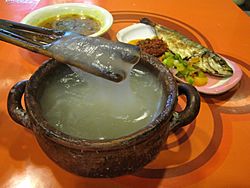Papeda (food) facts for kids

Papeda served with yellow soup and grilled mackerel called tongkol
|
|
| Alternative names | Popeda, Pepeda, Bubur Sagu, Nangu, Kapurung, Sinonggi |
|---|---|
| Course | Main course, staple food |
| Place of origin | Indonesia |
| Region or state | Sulawesi, Maluku and Papua |
| Serving temperature | Hot or room temperature |
| Main ingredients | Sago |
Papeda, also known as bubur sagu, is a special kind of congee (a thick porridge). It's made from sago starch and is a main food for many people in eastern Indonesia. You can find it in places like Sulawesi, the Maluku Islands, and Papua. Papeda is also popular in Papua New Guinea. It's like the main food there, just as rice is the main food in central and western Indonesian cuisines.
To get the sago starch, people cut down a sago palm tree. They split the trunk in half and scrape out the soft inside part, called the pith. This makes a rough sago flour. This flour is then mixed with water and squeezed. This process helps to separate the pure starch from the flour. The wet sago starch is often kept in a special container. This container is made from sago palm leaves and is called a tumang. The starch can stay fresh in a tumang for several months. After that, it might become too sour to use for papeda. A sago tree needs five to ten years to grow enough starch in its trunk to be worth harvesting.
Papeda is made by cooking sago starch with water. You stir it until it becomes thick and sticky. It looks and feels a bit like glue. People often eat papeda with side dishes. These can include sayur bunga pepaya (papaya flower bud vegetables) or tumis kangkung (stir-fried water spinach).
In southern Sulawesi, especially in Luwu and Tana Toraja, there's a similar dish called Kapurung. It's made from cooked sago porridge. People use chopsticks or a fork to roll it into a ball. Kapurung is usually served with beans, vegetables, and fish in a soup. In Southeast Sulawesi, among the Tolaki tribe, there's a dish called Sinonggi. This sago porridge is served separately from the other dishes, much like Papeda. You pick it up using special wooden sticks.
Similar dishes are found in other countries too. In Malaysia, it's called linut. This is part of the Melanau food in the East Malaysia state of Sarawak. In Brunei, it's known as ambuyat.
History of Papeda
In some coastal and lowland areas of Papua, sago is the main ingredient for almost all foods. Dishes like sagu bakar, sagu lempeng, and sagu bola are well-known throughout Papua. They are especially important in the traditional cooking of the Mappi, Asmat, and Mimika regions. Papeda is one of the sago dishes that is less common in some areas.
Johszua Robert Mansoben, an expert on Papua, says that Papeda is more widely known. It's part of the traditions of the native people around Lake Sentani, in places like Sentani and Abrab, as well as Arso and Manokwari.
Ways to Enjoy Papeda
Papeda is usually eaten with mackerel and fish broth. However, you can also have it with other fish like red snapper, tuna, or cork fish. Most of these fish are seasoned with turmeric and lime. This gives the broth a special yellow color. Sometimes, papeda is also eaten with boiled starchy root vegetables. These can include cassava or yam. Besides yellow broth and fish, you can enjoy papeda with sayur gameno. This dish is made from young melinjo leaves, stir-fried papaya flowers, and red chilies.
Images for kids
-
Natives of Seram island in Maluku cooking papeda in bamboo.



